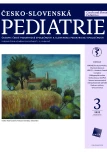Gender incongruence in childhood
Authors:
Neumann David 1; Fifková Hana 2,3; Zapletalová Jiřina 4; Šnajderová Marta 5; Weiss Petr 6,7
Authors‘ workplace:
Dětská klinika Lékařské fakulty Univerzity Karlovy a FN Hradec Králové
1; Sexuologická a psychoterapeutická poradna Praha
2; Dětská sekce Sexuologické společnosti ČLS JEP
3; Dětská klinika Lékařské fakulty Univerzity Palackého a FN Olomouc
4; Pediatrická klinika 2. lékařské fakulty Univerzity Karlovy a FN Motol, Praha
5; Sexuologický ústav 1. lékařské fakulty Univerzity Karlovy a Všeobecné fakultní nemocnice, Praha
6; Katedra psychologie Filozofické fakulty Univerzity Karlovy, Praha
7
Published in:
Čes-slov Pediat 2022; 77 (3): 170-174.
Category:
Overview
Gender incongruence in childhood refers to the mismatch between a child‘s individual conception of their own gender and their assigned sex at birth based on their physical sex characteristics. This condition may present as early as in the prepubertal age. The upsurge in the number of adolescents questioning their gender identity in recent years has generated pronounced interest to understand the basis of this incongruity and subsequently provide appropriate medical support. In the following review article, the authors provide a background about this subject in the Czech Republic.
Keywords:
gender incongruence in childhood – identity – body dysphoria – transsexuality
Sources
1. NRH ZS (Národní registr hrazených zdravotních služeb) 2010– 2020. Dostupné na: https://psychiatrie.uzis.cz/browser/disease/ juvenile. [15. 3. 2022]
2. de Graaf NM, Carmichael P. Reflections on emerging trends in clinical work with gender diverse children and adolescents. Clin Child Psychol Psychiatry 2019; 24: 353–364.
3. de Graaf NM, Giovanardi G, Zitz C, Carmichael P. Sex ratio in children and adolescents referred to the gender identity development service in the UK (2009–2016). Arch Sex Behav 2018; 47: 1301– 1304.
4. Mezinárodní klasifikace nemocí, 11. revize. Dostupné na: https:// icd.who.int/browse11/l-m/en#/http%3a%2f%2fid.who.int%- 2ficd%2fentity%2f411470068. [15. 3. 2022]
5. World Health Organisation 2016, ÚZIS ČR 2017. MKN-10: Mezinárodní klasifikace nemocí a přidružených zdravotních problémů, 10. revize. Dostupné na: https://apps.who.int/iris/bitstream/handle/ 10665/246208/9788074721687-V1-cze.pdf
6. Vymětal J. Obecná psychoterapie. 2., rozš. a přeprac. vyd. Praha: Grada 2004.
7. Gülgöz S, Glaziera JJ, Enright EA, et al. Similarity in transgender and cisgender children’s gender development. PNAS 2019; 116: 24480– 24485.
8. Griffin L, Clyde K, Byng R, Bewly S. Sex, gender and gender identity. BJ Psych Bulletin 2020; 1–9.
9. Pediatric endocrine society. Transgender health. Position statement. December 2020. Dostupné na: https://www.endocrine. org/advocacy/position-statements/transgender-health. [15. 3. 2022]
10. Turban JL. Potentially reversible social deficits among transgender youth. J Autism Dev Disord 2018; 48: 4007–4009.
11. Zucker KJ. Adolescents with gender dysphoria: reflections on some contemporary clinical and research issues. Arch Sex Behav 2019; 48: 1983–1992.
12. Hines M. Human gender development. Neurosci Biobehav Rev 2020; 118: 89–96.
13. World Professional Association for Transgender Health. Standards of care for the health of transsexual, transgender, and gendernonconforming people. 7th version. Dostupné na: https://www.wpath. org/media/cms/Documents/SOC %20v7/SOC %20V7_English2012. pdf?_t=1613669341. [15. 3. 2022]
14. APA : https://www.psychiatry.org/psychiatrists/cultural-competency/ education/transgender-and-gender-nonconforming-patients/gender-affirming-therapy. [15. 3. 2022]
15. Kinitz DJ, Salway T, Dromer E, et al. The scope and nature of sexual orientation and gender identity and expression change efforts: a systematic review protocol. Syst Rev 2021; 10: 14.
16. García RR, Ayuso-Mateos JL. ICD-11 and the depathologisation of the transgender condition. Rev Psiquiatr Salud Ment (Barc) 2019; 12: 65–67.
17. Ristori J, Steensma TD. Gender dysphoria in childhood. Int Rev Psychiatry 2016; 28: 13–20.
18. Steensma TD, Cohen-Kettenis PT. A critical commentary on “A critical commentary on follow-up studies and “desistence” theories about transgender and gender non-conforming children”. Int J Transgender 2018; 19: 225–230.
19. Hembree WC, Cohen-Kettenis PT, Gooren L, et al. Endocrine treatment of gender-dysphoric/gender-incongruent persons: an endocrine society clinical practice guideline. J Clin Endocrinol Metab 2017; 102(11): 1–35.
20. de Vries ALC. Challenges in timing puberty suppression for gender- -nonconforming adolescents. Pediatrics 2020; 146: e2020010611.
Labels
Neonatology Paediatrics General practitioner for children and adolescentsArticle was published in
Czech-Slovak Pediatrics

2022 Issue 3
Most read in this issue
- Autism spectrum disorders
- Gender incongruence in childhood
- Suicidality and self-harming in childhood and adolescence – actual situation
- Refeeding syndrome
